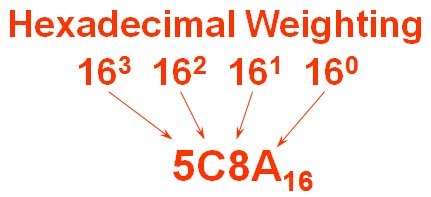Hexadeciaml Number System
Return to the numbers pages | Decimal Numbers | Binary Numbers | Hexadecimal Numbers | Octal Numbers | BCD Number | Negative Numbers | Number ConversionsHexadecimal, simply referred to as Hex, is a base-16 number system.
Most modern day PLC/PAC's use the hexadecimal number system some where within their architecture. Some PLC/PAC require that some instruction parameters be entered in Hex.
Base-16 numbers can be written in two formats:
2416 or 24h
in ControlLogix: 16#24
Base-16 also means that there are 16 valid numbers. Starting with zero they are:
0, 1, 2, 3, 4, 5, 6, 7, 8, 9
A, B, C, D, E, F
Where:
A = 10, B = 11, C = 12, D = 13, E = 14, F = 15
- Question to Ponder and Research
- Why the switch to letters? Why not simply use the numbers 10 through 15?
- How many bits of binary does it take to represent all 16 digits of a hex number?
- The answer is that it takes 4-bits of binary to represent any hex digit. The following table shows the hex digits and the corrisponding 4-bit binary number.
| Hex Number | 4-bit Binary |
|---|---|
| 0 | 0000 |
| 1 | 0001 |
| 2 | 0010 |
| 3 | 0011 |
| 4 | 0100 |
| 5 | 0101 |
| 6 | 0110 |
| 7 | 0111 |
| 8 | 1000 |
| 9 | 1001 |
| A (10) | 1010 |
| B (11) | 1011 |
| C (12) | 1100 |
| D (13) | 1101 |
| E (14) | 1110 |
| F (15) | 1111 |
Each digit in a hexadecimal number has a weight Value. The weight of a hex digit is the base raised to the power of the digit position. The figure below depicts an example.
Hexadecimal Weighting


